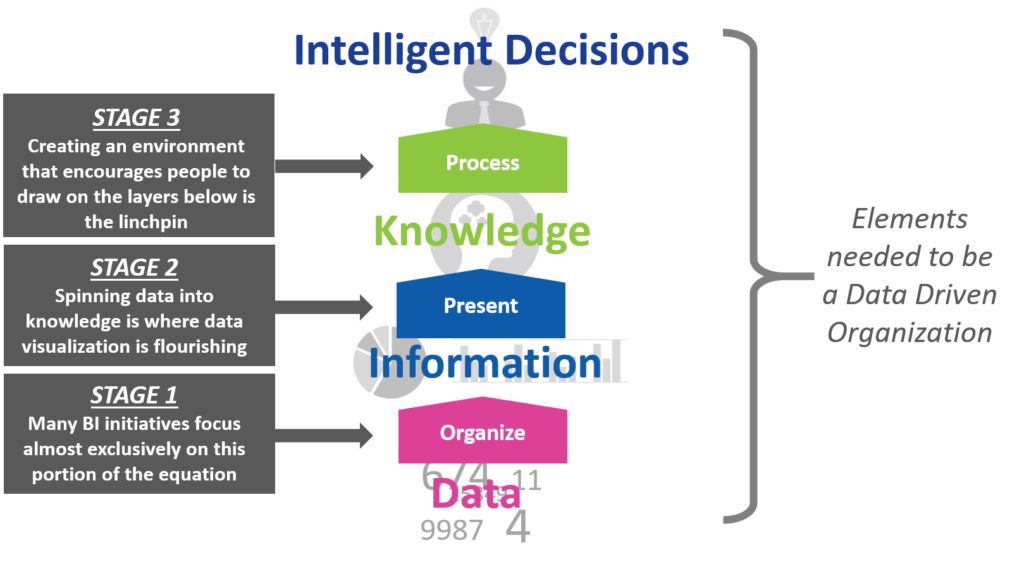by Robert Wolverton –
In a previously shared eBook, Strategic Context – A Life Hack for Your Business”, Thomas Clarke identified the significant problem of Strategic Awareness – the idea that while leaders are making decisions on the direction of an organization to deal with the ever-changing business and economic landscape, the rest of the people in the organization are “rowing in the dark”. There is a constant need to keep everyone informed regarding the corporate strategy and direction.
He also shared several approaches that RCG has used with our clients to , including:
- Clarify the Strategy
- Enhance the Communication
- Empower Resources
Under the Empower Resources heading, Thomas talked about “Monitoring progress against strategy and goals enables resources to visualize how targets are being achieved. Regular analysis and reporting provides a culture of strategic awareness and alignment.” The balance of this article will focus on this particular area and how to bring this level of reporting down to the lowest levels of an organization.
Origin of the “Metrics Cascade”
A number of years back, we worked on a data strategy project for a large healthcare system. The sponsor of the project, the Senior Vice president of Finance, Jeff Hurst, held a similar perspective to the one espoused by Thomas – that everyone in the organization should understand their part and how their individual contributions supported the strategy/mission and impacted the organization as a whole. Specifically, Jeff wanted to define metrics for every role that would roll up to the level above them, culminating in the strategic measures that support the overall strategy.
The project team proposed the creation of a “metrics cascade”. Essentially it involves defining measurable actions /activities /outcomes that could be measured, tracked and presented back to each individual within the company via their own personalized performance dashboard. These “mini dashboards” would be visible on the individual’s screen, allowing each one to know precisely what was needed from them for the organization to succeed and presenting their on-going results against these performance expectations.
The concept of putting such metrics in front of team members is certainly not new. Anyone in a sales role can tell you that their results are tracked and viewed by virtually every leader in the company. The biggest difference here is that we’re not tracking a single metric, but a number of them. Any CFO can tell you that if a company focuses exclusively on sales (the top line), it’s likely sales will be made without regard to margin and the overall profitability of the company (the bottom line) is severely impacted. It’s the achievement of the collection of metrics – those that support the strategic mission of the company – that generates organizational success.
Metrics-based Enlightenment
To enable the vision that Jeff laid out requires overcoming several significant challenges:
Challenge 1: Define the Metrics Cascade
While it seems fairly simple on the surface, this step is arguably the most difficult and time consuming. The highest levels are fairly straightforward as these metrics have likely been tracked for years and are well-known across the organization (total sales, total administrative costs, cost of goods sold, gross margin are just a few examples). At each successively lower level, things become more complicated. Understanding which costs are associated with which part of the organization and which activities performed can be difficult to determine. Old-school Activity-Based Costing exercises may be needed to figure out how much effort is expended to say, process an incoming payment and assign a cost to it. Playing into this process of defining the metrics cascade is the potential need to measure and collect data that the organization previously ignored or lacks the ability to capture. In some cases, metric “proxies” will have to be used to help create metrics that never existed before.
Building a visible map that shows how top-line metrics cascade down to more specific measures at each level helps everyone throughout the organization to understand how their performance measures tie back to the overall organization performance metrics.
Challenge 2: Collect the Data
As suggested above, the ability to collect data should be considered when the metrics cascade is being defined. Once the metrics have been identified, the process of collecting the data at the right level of granularity must be accomplished. This generally much more detailed than is typically done by an organization, since it ties to activities of specific individuals. Companies with call center-based employees will be familiar with this level of granular data capture. Applying similar levels of vigor to capture and store data for every employee across an organization is a potentially daunting task. Company leaders should expect delays in capturing each of the desired metrics at this level since it is tedious work that doesn’t move quickly.
As data is captured and storage mechanisms are defined, it’s important to keep in mind the possibility of changes down the road. The probability that the company will adjust its strategy on a fairly regular basis (especially as the pace of change continues to accelerate). Utilizing flexible data storage structures is important to prevent a lot of re-work whenever the winds of change come blowing through.
Additionally, consider how frequently the data can and should be collected. How often a metric changes should play into the decision. If it remains rather static, the frequency of gathering this data can be diminished. On the other hand, if the metric varies significantly, collection frequency should be increased to prevent sampling bias that could have a negative impact on decision making.
Challenge 3: Present the Data
Once the data collection and storage has been overcome, the challenge of how to get this data to each individual in a timely, easy-to-understand fashion comes front and center. Very few people have the ability to see anomalies in a collection of numbers. Jeff Hurst had the uncanny ability to look at a spreadsheet filled with hundreds numbers and pinpoint values that were “wrong”. He would ask people to investigate and they would invariably find an error or data anomaly of some kind. Since few people are blessed with such superpowers, data needs to be presented in a usable, visual fashion showing targets/goals along with actuals-to-date and projections for the full performance period.
This allows each individual to see how they are performing at present and how their current and past performance projects into the future. Projections need to be considered with a bit of caution since people can quickly become discouraged if they feel their goals are no longer achievable.
This information should be made easily accessible for every user in the organization. A personalized, mini-dashboard that sits in the background of each user’s desktop will make the information easy to find and likely to be seen on a regular basis.
Challenge 4: Draw Attention to the Metrics
Connecting the dots back to Thomas Clarke’s “Enhance the Communication” approach, it’s important to have regular conversations about these cascaded metrics. These conversations are probably best conducted at the team-level. This enables the individuals to see how their own performance and the performance of their colleagues build upon one another and eventually roll up to the organization’s performance.
It’s also important during these metrics review sessions to publicly praise high performers and have them share some of their “secrets to success”. Conversely, refrain from publicly humiliating under-performers – the individual metrics provided to them help them understand where they stand and public humiliation is highly unlikely to motivate or generate positive behavior.
Benefits of the Metrics Cascade
Defining and enabling the Metrics Cascade provides a number of tangible benefits for both individual performers and the organization as a whole.
Benefit 1: Fast Flexibility
Establishing a fully functional metrics cascade environment creates a flexible structure that can change quickly as strategic priorities shift. It allows metrics to be adjusted to support a shift in strategy – for example, moving from a “speed to market” to a “cost containment” focus.
Benefit 2: Elastic Aggregation
The cascade also enables performance metrics from each individual to be aggregated at various levels of the organization. This provides the ability to quickly identify high and low performers – who needs help and who is best suited to help those that need it (high performers teach low performers). It shows performers / teams what’s possible (people to tend to think they are doing well, but may be under-performing when compared to peers – the ability to see “what’s possible” can motivate individuals and teams to higher levels of performance).
Benefit 3: Data Driven Business
Capturing and leveraging data to monitor performance from the individual to the organizational level enables the data driven business that many have sought to establish. The metrics cascade is one important aspect of becoming data driven. It helps to drive prioritization of information needs since it helps organizations understand what is important and ensure mechanisms are established for measurement and capture.
Providing Performance Enlightenment
Moving toward a data driven business by creating a metrics cascade and providing performance enlightenment to all levels of the organization will enable your company to thrive in an ever-changing world. Information that is aligned with the corporate strategy and provides on-going feedback to all employees is critical to ensure that everyone is “rowing in the same direction”. RCG stands ready to help you become the hero of your organization and deliver benefits over the long term. The path to data-driven success can be difficult, but assistance from experts at RCG can help you and your organization achieve outstanding results.

Becoming Data Driven
RCG worked closely with a change management expert to develop a “Becoming Data Driven” presentation for a business intelligence conference. If you would like to participate in a deeper dive of this content, please contact us.

